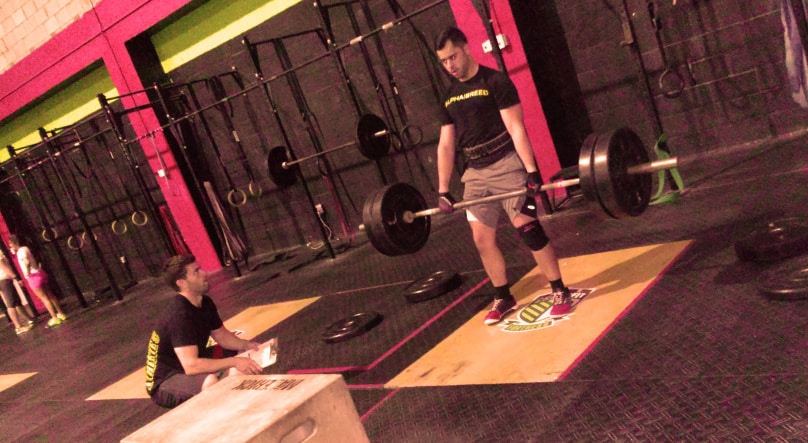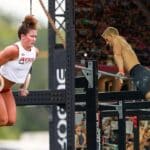There are a few stories from the affiliate community that tell of Chris Spealler explaining to coaches that the heart and soul of CrossFit—that is to say, the foundation of a CrossFit workout—are couplets and triplets.
For those of you who don’t know, a couplet is a pairing of two functional movements—usually (though not always) a classic weightlifting movement ‘coupled’ with a classic gymnastic or callisthenic movement. These two movements should also compliment each other in the sense that one should be a ‘pull’ movement, while the other should be a ‘push’ movement. For example, Fran (21-15-9 thrusters and pull-ups) is a perfect example of a classic couplet, using the ‘push’ of a thruster combined with the ‘pull’ of a pull-up. Furthermore, by offsetting a push movement with a pull movement, you give yourself time to ‘rest’ as you are actively working. Let me explain: Traditional interval workouts have rest time built into the workout—the rest period is literally the ‘interval’ between movements. The intent is to allow the athlete to recover between work periods so they can perform the next exercise at high intensity—hence the abbreviation HIIT: High Intensity Interval Training.
What couplets do is create a sense of rest by targeting one area or one group of muscles for the first movement, then ‘resting’ them by utilizing a different group of muscles for the second movement. If we take Fran as an example, your legs will be shot from all those thrusters—it would make little sense to then go into goblet squats, especially when the workout is designed to be done as quickly as possible. Instead, your legs get a ‘break’ while your upper body does the work during the pull-ups, then the sequence repeats until the three rounds are complete. Couplets remove the interval period entirely while still allowing you to perform sets of two different movements at a high intensity.
A triplet is similar in design to the couplet, but naturally the inclusion of a third movement allows for more variety, movement patterns and a broader range of fitness. Of course, it’s a little trickier to split up the push-pull as can be done in a couplet, but triplets allow you to play around with more cardiovascular-intensive movements like running and double-unders. Helen is a good example of a triplet, combining running, kettlebell swings and pull-ups.
Most of you will be exposed to couplets and triplets in your WODs at least twice a week, if not more. They are the core foundations of metcons (metabolic conditioning workouts), and are usually performed as an AMRAP (as many rounds as possible) in a given time frame (time priority) or as a task priority workout, in which you must complete all the rounds for the best possible time. Ben Bergeron, head coach at CrossFit New England (CFNE), explains how he programs couplets and triplets into his classes and gives advice for other coaches to do the same:
I suggest coaches create a template for their box. They talk about this at the Level 1 Seminar, but I think it’s all too often overlooked. Let the meat and potatoes of your program be your couplets and triplets, go long once a week, and go heavy one to two times per week. After several years of playing around with creating structure to my programming, I found something that has worked quite well and allows me to be honest and consistent in how I program, no matter what.
For regular weekly CFNE gym programming, we try to incorporate:
3-4 days of couplets/triplets, 6-15 minutes long
1-2 days of strength
1 day of a long, 20+ minute workout
1 day with no shoulders
1 day with no barbell
1 day with a benchmark
As Spealler tells us, couplets and triplets are the foundation of CrossFit, that’s evident by the number of benchmark WODS that are based off of those principles. So, lets take a look at some of the best (and most iconic) couplet/triplet WODs out there:
Jump to:
COUPLETS
FRAN
21-15-9
Thrusters (95/65lbs), Pull-Ups
DIANE
21-15-9
Deadlifts (225/155lbs), Handstand Push-Ups
ELIZABETH
21-15-9
Cleans (135/95), Ring Dips
ANNIE
50-40-30-20-10
Double-Unders, Sit-Ups
NICOLE
20-Minute AMRAP
400 meter run, Max Rep Pull-Ups
AMANDA
9-7-5
Muscle-Ups, Snatches (135/95lbs)
GATOR (HERO WOD)
8 Rounds
5 Front Squats (185/125lbs), 26 Ring Push-Ups
SEAN (HERO WOD)
10 Rounds
11 Chest-to-Bar Pull-Ups, 22 Front Squats (75/55lbs)
TRIPLETS
CINDY
20-Minute AMRAP
5 Pull-Ups, 10 Push-Ups, 15 Air Squats
HELEN
3 Rounds
400 Meter Run, 21 Kettlebell Swings (24kg), 12 Pull-Ups
JACKIE
1000 Meter Row, 50 Thrusters (45/30lbs), 30 Pull-Ups
MARY
20-Minute AMRAP
5 Handstand Push-Ups, 10 alternating pistols, 15 Pull-Ups
NATE (HERO WOD)
20-Minute AMRAP
2 Muscle-Ups, 4 Handstand Push-Ups, 8 Kettlebell Swings (32kg)
ZIMMERMAN (HERO WOD)
25-Minute AMRAP
11 Chest-to-Bar Pull-Ups, 2 Deadlifts (315/214lbs), 10 Handstand Push-Ups
NASTY GIRLS
3 Rounds
50 Squats, 7 Muscle-Ups, 10 Hang Power Cleans (135/95lbs)
Photo courtesy of CrossFit Fortress














